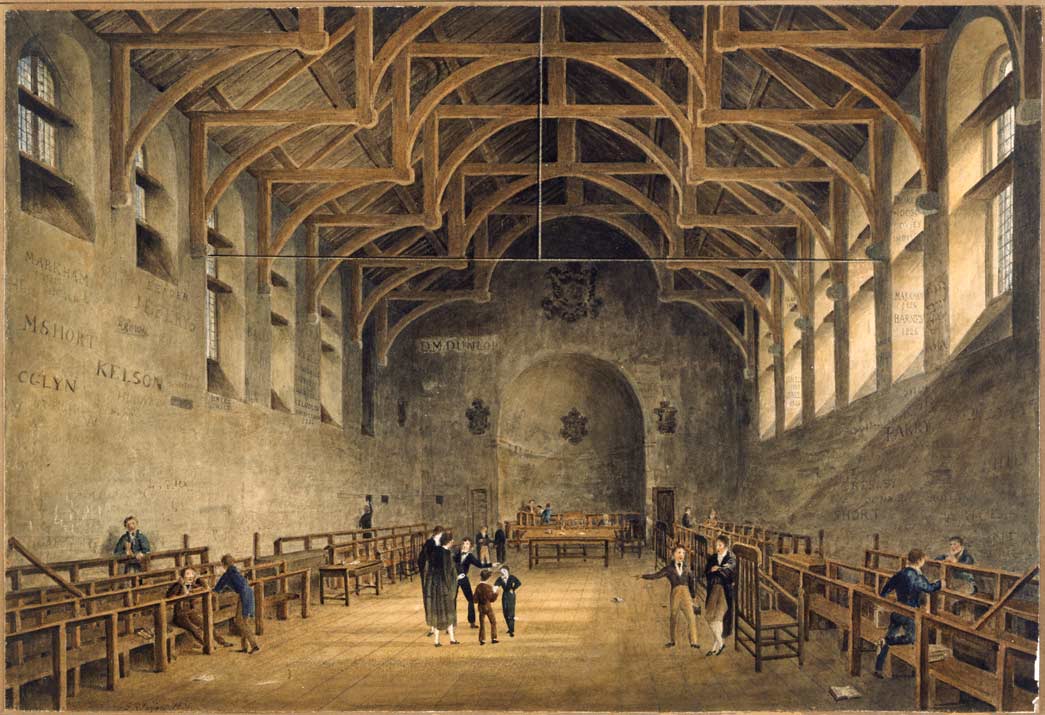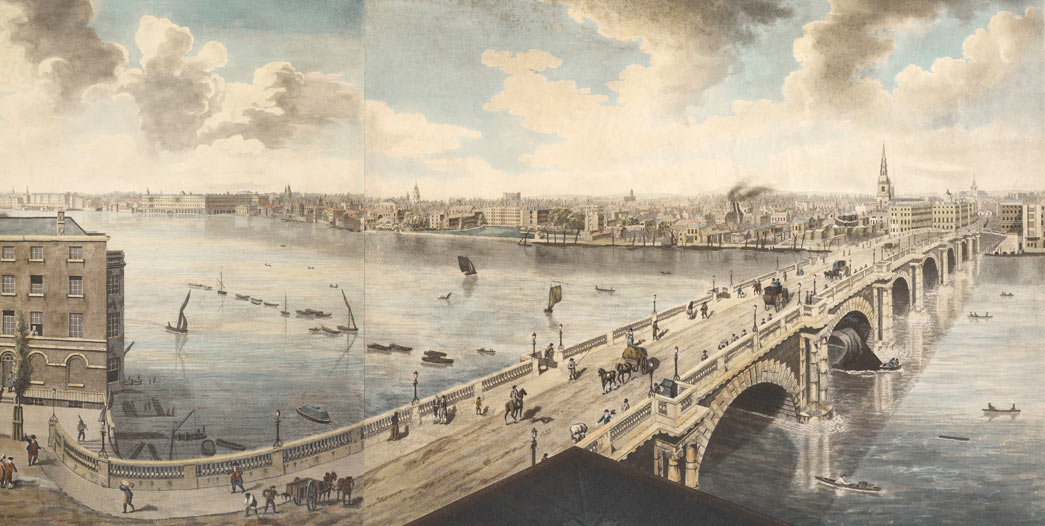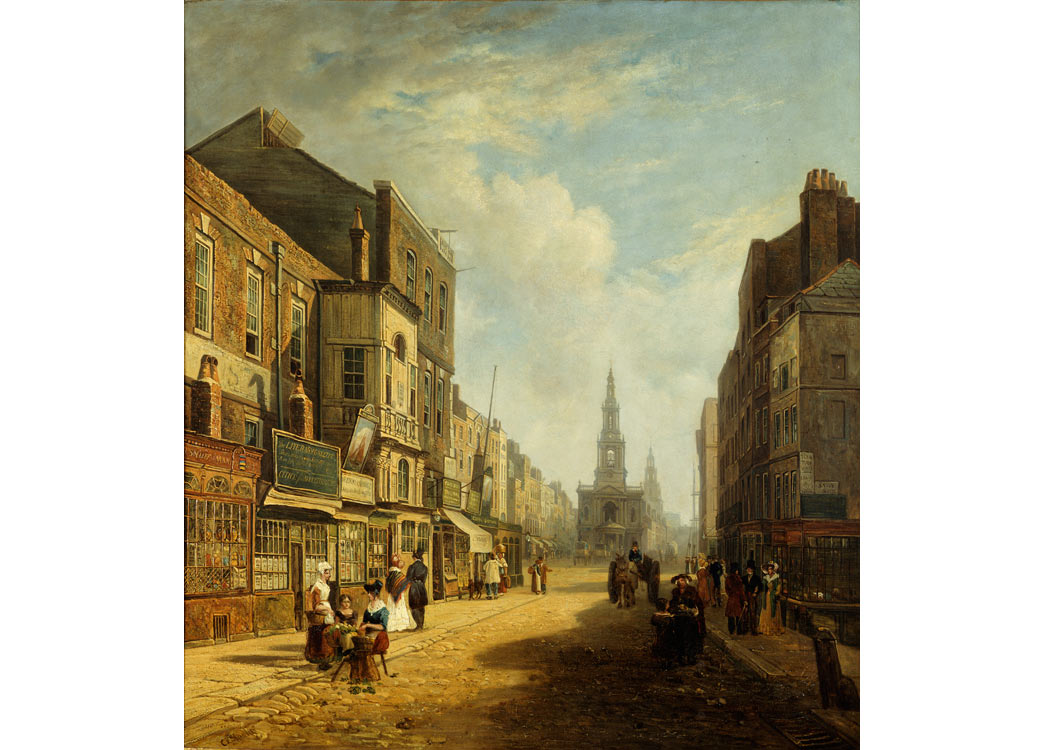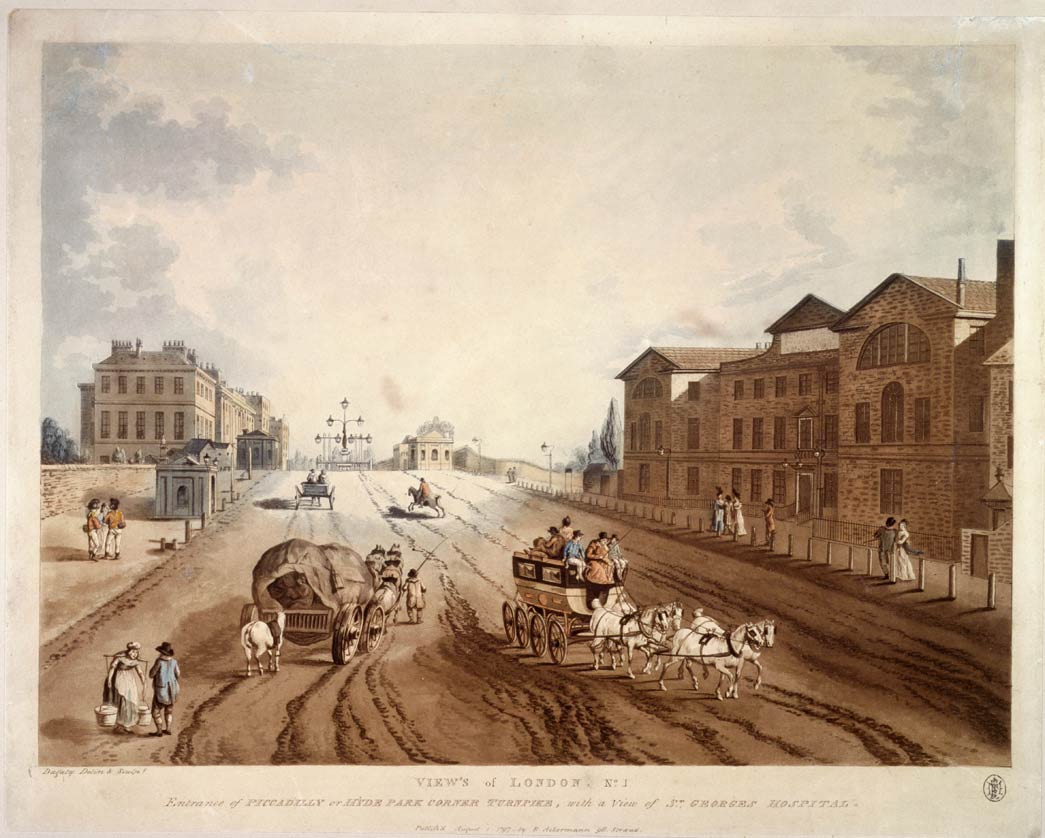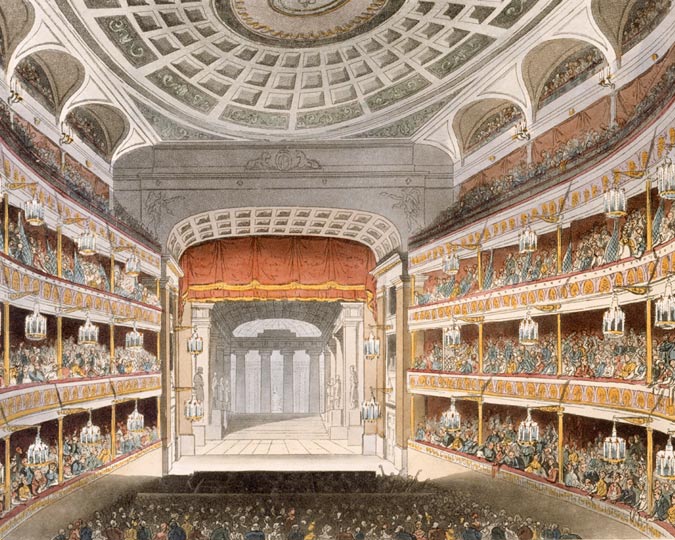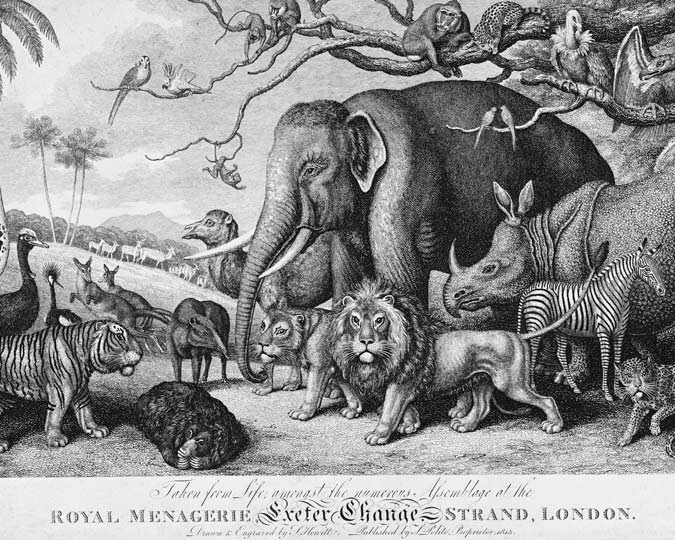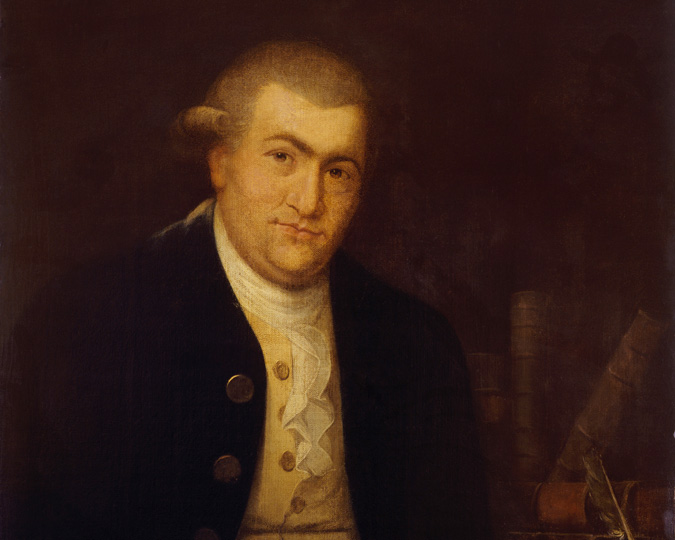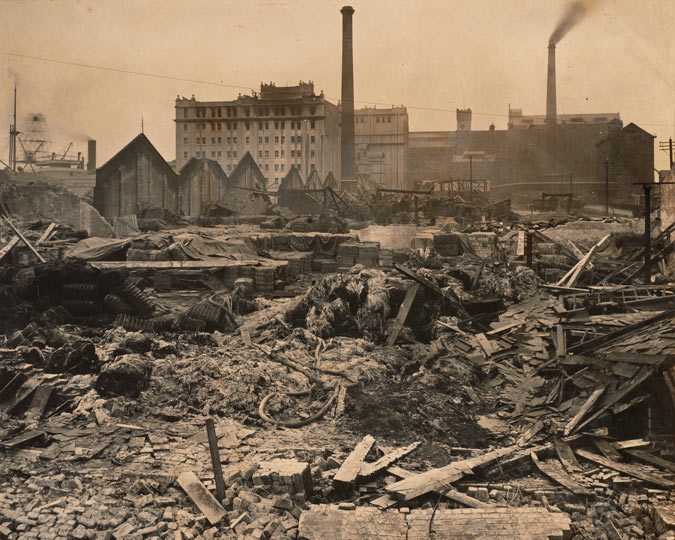Day 15: Westminster School & Bedlam Asylum (28 March 1814)
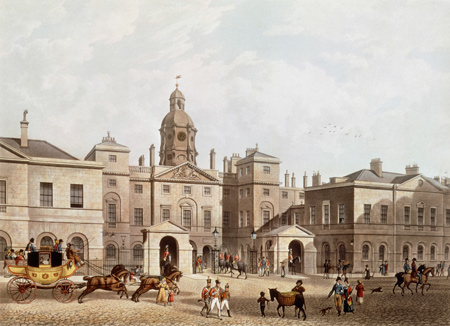
A View of the Horse Guards from Whitehall, 1816
Coloured aquatint, Thomas Hosmer Shepherd; ID no. A18158
Our fifteenth morning was beautifully fine but fine as it was it was not without a cloud for my Uncle was unwell with a shocking bad cold. About eleven we set off to St James’s park where we saw the Horse guards. Relieved from thence we went to Deans Yard to Westminster School having previously pass’d thro the Abbey and took a peep at the Poets Corner. Our errand to the School was to call on Mr Edward Willey but were disappointed in not finding him at home.
After taking a farewell view of the exterior of the venerable Abbey and Westminster Hall and once more passing over Westminster bridge we came to St. Georges fields where on the ground on which the Dog & Duck and famous Tea gardens stood is now erected a noble and immense building for the Reception of Lunatics which is called the New Bedlam. The centre is not yet completed [opened 1815] but which when finished will be very handsome indeed. It is crowned with a noble Doom [sic] and in the front is a row of fine pillars. This will be one of the largest and finest Structures this vast city contains.
We next pass’d Surry Theatre which is now fitting up in imitation of Covent Garden, near it is the Magdalean Hospital and Nelson Square. We also pass’d Rowland Hill’s Surry Chapel then to Mr Prowetts where we sat a few minutes. A little further brought us to Black Fryer’s bridge upon which we had a beautiful and extensive view of the City. We here counted forty seven churches.
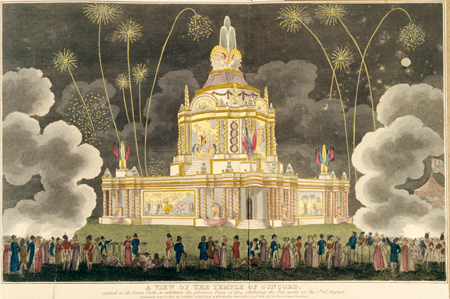
Perspective view of the revolving Temple of Concord, 1814
This temple was built in Hyde Park in summer 1814 to celebrate the defeat of Napoleon & the end of over 20 years of war with France. ID no. A21025
We next saw Apothecary hall, Doctors Commons, and the prerogative court office, where Wills are registered. We pass’d St Pauls’s School, and call’d on Messrs Bell & Broderick. Bow Church Yard, called on Mr Dawes and at the White Bear in Basinghall St. and Oxford Arms to enquire respecting a Waggon. We saw the College of Physicians in Warwick Lane. At St Andrews Church Holbo[r]n we took a coach, which soon convey’d us to the Rainbow. I must not omit mentioning that we had the pleasure of hearing the Park and Tower Guns firing on account of the Allies entering Paris.
[Soldiers of the Sixth Coalition against Napoleonic France, which included Britain, Russia and Prussia, reached Meaux on the outskirts of Paris on 28 March 1814. The French surrendered on 30 March.]
Mrs Baker and Mrs Brice call’d upon us, about half past four we sat down to dinner, after it Mr Harting the Duke of Norfolk’s Steward call’d on my Uncle, at eight we took our Tea after it backgammon, and soon after ten we retired to rest.
Day 16: "The astonishing performance of a needle" (Tuesday 29 March)

Napoleon Bonaparte, embroidered by Mary Linwood
In worsted wool, 1825. © Victoria and Albert Museum, London.
On our Sixteenth morning my Uncle set off into the city alone and we went into Leicester Square to see Miss [Mary] Linwoods exhibition of worsted work, which is arranged in two rooms one hundred feet in length and most elegantly fitted up. One is call’d the gothic room which has a very fine effect and is very singularly designed.
The Pictures are exquisitely beautiful beyond description they have the appearance of the finest paintings, no one could have an idea of their being the performance of a needle. After spending a considerable time in viewing these most astonishing specimens of this celebrated workwoman which very far exceeded our expectations much as we had heard of it, we returned to the Rainbow then walked into the Strand as far as Temple Bar. Returned to dinner by half past four, in the evening reading, writing and Backgammon.
Day 17: Sun on the Strand (Wednesday 30 March)
On our Seventeenth morning which was beautifully fine we again set off into the Strand. My Uncle here gave us an unexpected treat in a few minutes we had the beautiful city of Berlin before our eyes the exact resemblance to nature in this Panarama is beyond description. The day being so fine the addition of the Sun added greatly to its beauty we were a considerable time in viewing this charming picture, we at last left it with reluctance for we were continually finding out some new object which astonished us. We proceeded thro Fleet Market, St. Pauls church yard, and home again thro Cornhill & Cheapside. We dined at half past four, in the evening writing & backgammon.
Day 18: Peep at a Princess (Thursday 31 March 1814)
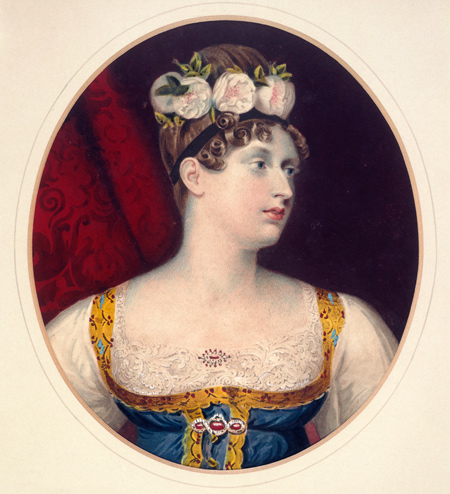
Portrait of Princess Charlotte of Saxe-Coburg, 1816
Princess Charlotte was the only daughter of George IV & Queen Caroline. She died after childbirth in 1817.
On our eighteenth morning my Uncle went into the city, and we set off alone. We bent our course into Piccadilly down St James Street thro the Stable yard into the park and to the Queens Palace to take a last look at that royal mansion, there was a carriage in waiting which from the livery we found belonged to the family. We were soon informed it was the Princess Charlottes. We felt a strong inclination to embrace this opportunity of catching a glance however transient of this great personage.
We loitered about a long time in expectation of seeing the carriage draw up, at last the palace doors were thrown open and two Ladies step’d into the carriage we instantly placed ourselves in that direction that we had a full view into the carriage, which for a few yards coming out of the gate way only went foot pace, and we standing tip toe and making the very best use of our eyes, were highly gratified in having a full view of her Royal Highness who was attended by the Duchess of Leeds.
We proceeded to Hyde park thinking we might perhaps have a second look but were disappointed. We returned thro Berkel[e]y Square Bond street and Piccadilly much pleased with having been so fortunate as to see the Princess Charlotte of Wales. In the evening we prepared for our departure by collecting our different articles together and my Uncle settled with Mr Godfrey.
Day 19: Home from a charming journey (1 April 1814)

Walking dress, 1814
A practical woman's costume when Elizabeth visited London. ID no. 2002.139/2340
On our nineteenth morning the first of April we concluded our visit to London, a visit we shall long remember and very often think of with the greatest pleasure and shall ever reflect with gratitude on our Uncles great kindness to us in giving us so great a treat as in making us his companions in this charming journey which we have so much enjoy’d and for all the trouble he has had on our account in showing us I may almost say every thing in London worth the attention of a Stranger.
We this morning breakfasted at eight O’clock and soon after nine the Chaise drove up to the door in which we presently seated ourselves and bid adieu to the Rainbow. In driving down Piccadilly we pass’d on our right the Pulteney Hotel the residence of the Duchess of Oldenburgh sister to the Emperor of Russia who is just arrived in England. Instead of passing thro Hyde park we went thro Knightsbridge, we were struck with the great alteration in the appearance of vegetation which the fine gentle rains had produced; the corn and grass fields looked beautiful which when we came looked so brown, a great contrast to the verdure in which they are now clad.
We changed horses at Cranford bridge, and at Maiden Head, then to Reading, we had a view of the ruins of an Abbey which when in its prosperity was a magnificent building. We had a delightful ride to Spinham lands where we with pleasure took up our lodgings for the night this excellent Inn made a very favourable impression upon us. After dinner we had a little conversation with the Landlady a very clever genteel woman and she was well acquainted with Yorkshire which she appeared pleased in talking of in the evening we had a hit at backgammon at eleven retired to rest.
Day 20: Back to Bath (2 April 1814)
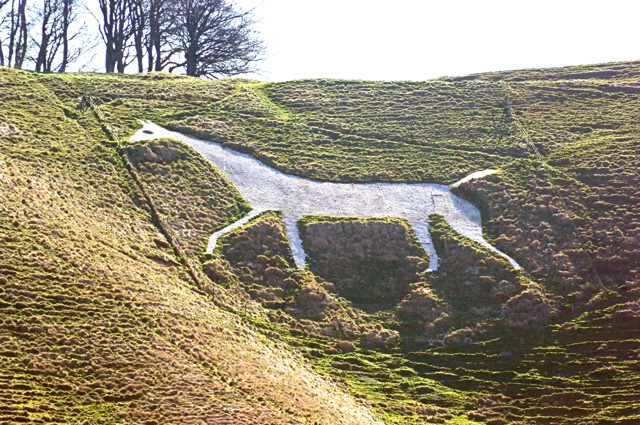
White horse at Cherhill, near Marlborough
This may have been the white horse seen by the Chivers. Photograph by Keith Park, CC-BY-SA.
The next morning, our twentieth day, we set of precisely at eight we pass’d thro Frogfield between it and Hungerford are wooden barracks and large magazines of gunpowder at Frogfield is a large building for distressed Clergymen’s widows, we had a ride of nineteen miles to Marlboro. at which place we made an excellent breakfast, after it we proceeded to Chipmam near Marlboro we were surprised at seeing a fine White Horse, which appeared to be standing against the side of a hill, it is formed in the chalk it is a most excellent depiction.
After passing the grey Wethers and Silbury Hill we came to Beckhampton Inn where we proceeded straight forward to Chipmam a new road to us we here pass’d over a very wild tract of country which put us in mind of the Yorkshire Wholds, had it been clear we should have had a fine and extensive prospect but sad to relate we had a most tremendous storm, We pass’d thro Calne a mile or two further we had a view of Beau Wood a fine house a seat of the Earl of Shelborne. We soon came to the antient town of Chipmam, where we changed horses a little out of it we pass’d a very pretty house or two, with beautiful grounds. We had also a good view of Corsham House Paul Methuen Esqr. which is a noble mansion and famous for one of the most valuable collections of paintings in the kingdom.
The country here is beautiful, fertile vales, pretty hills and a number of rural cottages here and there dispersed and the fine hills so familiar to our view surrounding Bath now form’d a part of this most beautiful and romantic scene. After passing thro Box and Batheaston, we had once more the pleasure of arriving safe at Bath, and had the happiness of finding my Father & Mother quite well.








